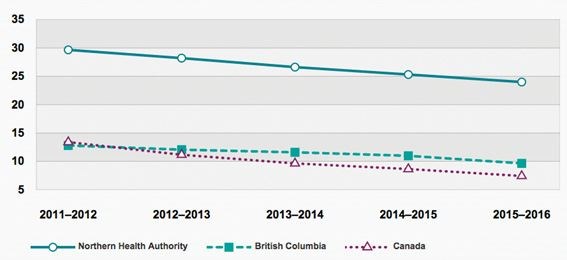Give it to me straight, doc.
That's the stereotypical response from the individual who has been given some bad health news but the doctor is providing a complex, technical assessment using medical terminology.
Unfortunately, Northern Health isn't giving it to us straight on its reasons for the use of restraints in long-term care facilities.
The attached graphic is an illustration from a national report that found that Northern Health has been putting its long-term care residents in daily physical restraints far more frequently than both the provincial and national averages for at least the last five years.
In fact, the provincial average would be lower except for Northern Health. Every other health authority in the province is much closer to the national average.
While Northern Health has seen some improvement, it still hasn't kept pace with the rest of the country. In 2011-2012, Northern Health was only double the national average. Last year, it was more than triple.
So far, Northern Health is blaming everyone... except Northern Health.
They say there are data quality issues with the Canadian Institute for Health Information, the national independent body that compiles and publishes health region data, even though CIHI is willing to work with them to address any concerns.
They say there is a problem with definition of restraints, even though the CIHI definition matches Northern Health's.
They say they follow guidelines on when and how to use restraints, forming individual profiles with the blessing of either the resident and/or their family.
That's fine except it's safe to assume that every other health authority in the province and the country has similar protocols in place.
If they aren't the same, Northern Health might want to reconsider its guidelines.
They say restraint use is a complicated measurement involving precise coding procedures.
Again, it's safe to assume that variable is not much different in other health jurisdictions. Again, if it's not the same and other health regions have a better, more efficient system, Northern Health might want to adopt that.
Two things have been missing from Northern Health so far.
First, an admission that the numbers are, in fact, correct and that Northern Health has work to do to improve its use of physical restraints, not just to reduce use but to catch up with the rest of the province and the country.
Second, an actual explanation of why Northern Health's numbers are so high and have been for years.
Why were 46.6 per cent of the residents in Gateway Lodge restrained daily in 2011-2012 and what was done to reduce that number to 32.4 in 2015-2016?
Why has Peace Villa in Fort
St. John gone up to 40.1 per cent from 35 per cent over the last five years?
Long-term care residents are restrained to protect them from falls and for other safety reasons, including protecting others from harm.
That is the case in Northern Health and everywhere else yet, for reasons Northern Health can't and won't say, the residents in their facilities need to be restrained far more often than elsewhere.
We're still waiting for the straight answer.
-- Managing editor Neil Godbout



